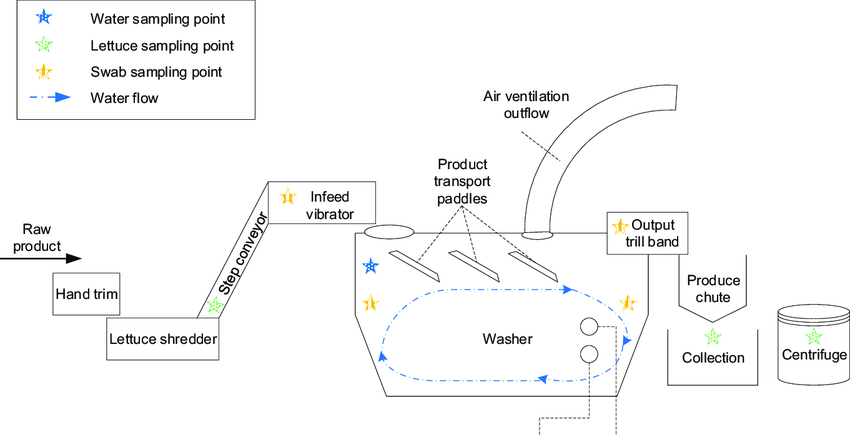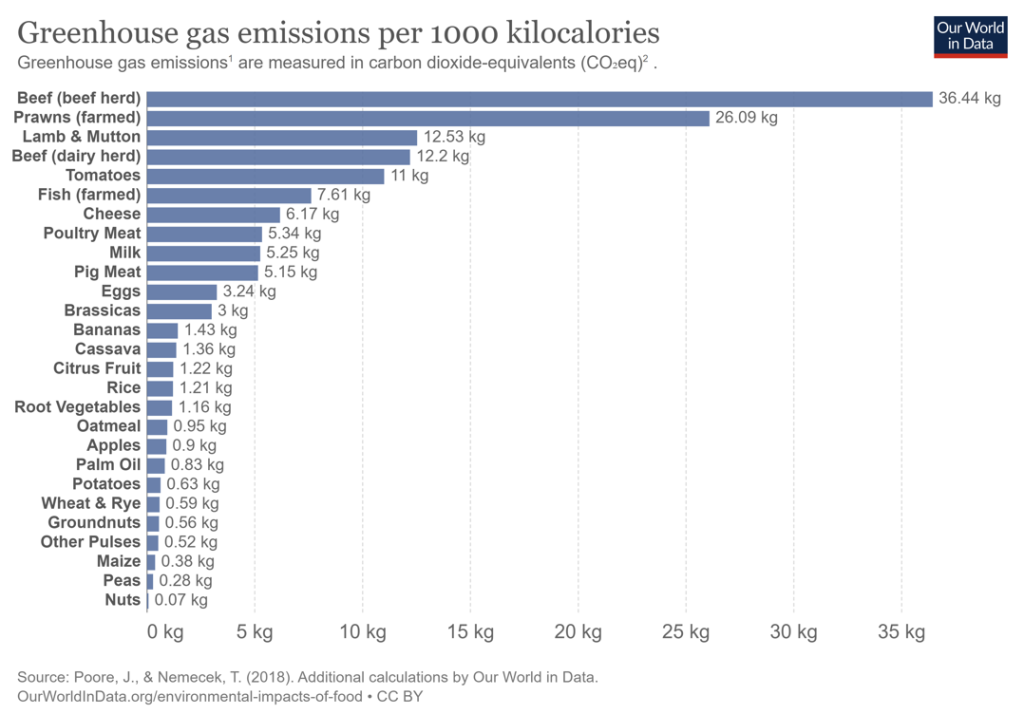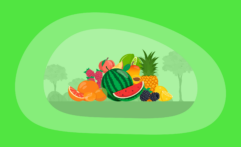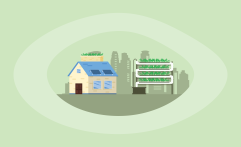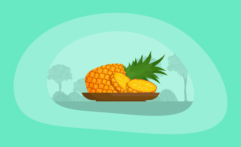What Is the Carbon Footprint of Lettuce? A Life-Cycle Analysis
Impactful Ninja is reader-supported. When you buy through links on our site, we may earn an affiliate commission.
Learn more
Learn more
.
Hey fellow impactful ninja ? You may have noticed that Impactful Ninja is all about providing helpful information to make a positive impact on the world and society. And that we love to link back to where we found all the information for each of our posts. Most of these links are informational-based for you to check out their primary sources with one click. But some of these links are so-called "affiliate links" to products that we recommend. First and foremost, because we believe that they add value to you. For example, when we wrote a post about the environmental impact of long showers, we came across an EPA recommendation to use WaterSense showerheads. So we linked to where you can find them. Or, for many of our posts, we also link to our favorite books on that topic so that you can get a much more holistic overview than one single blog post could provide. And when there is an affiliate program for these products, we sign up for it. For example, as Amazon Associates, we earn from qualifying purchases. First, and most importantly, we still only recommend products that we believe add value for you. When you buy something through one of our affiliate links, we may earn a small commission - but at no additional costs to you. And when you buy something through a link that is not an affiliate link, we won’t receive any commission but we’ll still be happy to have helped you. When we find products that we believe add value to you and the seller has an affiliate program, we sign up for it. When you buy something through one of our affiliate links, we may earn a small commission (at no extra costs to you). And at this point in time, all money is reinvested in sharing the most helpful content with you. This includes all operating costs for running this site and the content creation itself. You may have noticed by the way Impactful Ninja is operated that money is not the driving factor behind it. It is a passion project of mine and I love to share helpful information with you to make a positive impact on the world and society. However, it's a project in that I invest a lot of time and also quite some money. Eventually, my dream is to one day turn this passion project into my full-time job and provide even more helpful information. But that's still a long time to go. Stay impactful,Affiliate Disclosure
Why do we add these product links?
What do these affiliate links mean for you?
What do these affiliate links mean for us?
What does this mean for me personally?
There is a bounty of lettuce varieties to choose from including romaine, iceberg, and little gem. Lettuce is high in nutrition, but low in calories. It is also rich in vitamin A, and folates, making it a very healthy choice. A star of every salad, lettuce is a very popular vegetable, with 10.7 lb of lettuce consumed per capita. Yet, much less is shared about the environmental impact, and especially the carbon emissions of lettuce. So we had to ask: What is the carbon footprint of lettuce?
Lettuce has a carbon footprint of 0.26 kg (0.57 lb) of CO2e per pound of produce, which is relatively low for crops. Over 82% of this carbon footprint is caused by the resources used in the growing process. Choosing organic, whole, unpackaged produce is the most sustainable way to purchase lettuce.
In this article, we’ll walk you through the overall carbon emissions of the life-cycle of lettuce. From growing and packaging, to transportation and end-of-life practices, you will learn how this vegetable affects the planet and discover some ways to reduce and offset the footprint.
Here’s How We Assessed the Carbon Footprint of Lettuce
The carbon footprint is one of the ways we measure the effects of our human-induced global climate change. It primarily focuses on the greenhouse gas (GHG) emissions associated with consumption, but also includes other emissions such as methane (CH4), nitrous oxide, and chlorofluorocarbons, and is generally expressed in carbon dioxide equivalents (CO2e).
“Carbon footprint: the amount of greenhouse gases and specifically carbon dioxide emitted by something (such as a person’s activities or a product’s manufacture and transport) during a given period”
Merriam Webster
Basically, it is the amount of carbon emitted by you as an individual or an organization providing you with goods and services – including lettuce:
- This includes GHG emissions from producing the products that we use and foods that we eat (e.g., power plants, factories or farms, and landfills)
- GHG emissions from fuel that we burn directly or indirectly (e.g., logistics and transportation, cooling or heating facilities),
- as well as the GHG emissions attributed to how we consume these products and foods.
To understand the carbon footprint of lettuce, we must assess its life-cycle and each stage’s sustainability. This life-cycle assessment (LCA) is a method to evaluate the environmental impacts of products and materials.
Here’s the Overall Carbon Footprint of Lettuce
The overall carbon footprint of lettuce is 0.26 kg (0.57 lb) of CO2e per pound of produce, which is relatively low. Lettuce has a lower carbon footprint than other salad vegetables such as salad mix, tomato, cucumber, and bell pepper.
| The carbon footprint of lettuce | 0.26 kg (0.57 lb) of CO2e per pound of lettuce |
So, let’s have a look at each stage of the LCA of lettuce!
| The life-cycle stages of lettuce | Each stage’s carbon footprint |
| Growing of lettuce | The carbon footprint of growing lettuce is 0.21 kg (0.47 lb) of CO2e per pound of lettuce. This makes up a significant 82.70% of the overall carbon footprint of this vegetable. This is because of the pesticide, water, and land usage. |
| Harvesting, processing, and packaging of lettuce | The carbon footprint of harvesting, processing, and packaging lettuce is <0.009 kg (<0.02 lb) of CO2e per pound of produce. This makes up a tiny 0.12% of the overall carbon footprint of this crop. This is because lettuce is hand-harvested and usually unprocessed. |
| Transporting of lettuce | The carbon footprint of transporting lettuce is 0.009 kg (0.02 lb) of CO2e per pound of produce, which makes up 3.5% of the overall carbon footprint. Most lettuce is grown in the US. But, with imports increasing, the carbon emissions could become more harmful to the environment. |
| End-of-life of lettuce | The carbon footprint of the end-of-life of lettuce is largely impacted by the amount of food wasted. Lettuce is one of the most wasted foods, making up 21.9% of all wasted salad, with 65,100 tons being wasted a year. Lettuce is often wrapped in plastic packaging, which is bad for the environment, but lengthens the shelf-life of lettuce, leading to less food waste. |
These four stages can be broken down in more detail to understand why the carbon footprint of lettuce is relatively low in comparison to other vegetables.
What Is the Carbon Footprint of Growing Lettuce
The carbon footprint of growing lettuce is 0.21 kg (0.47 lb) of CO2e per pound of lettuce. This makes up a significant 82.70% of the overall carbon footprint of this vegetable. This is because of pesticide, water, and land usage.
Lettuce is easy to grow, both hydroponically and vertically. These innovative methods of farming aim to decrease the carbon footprint of the growing process.
Which factors impact the carbon footprint of growing lettuce?
- How do lettuces grow: Lettuce is grown above ground, either in fields or greenhouses. Lettuce is an ideal crop to grow in vertical farms, which helps reduce the carbon footprint exponentially. With a greater shift towards a vertical farming system, consuming lettuce will become less impactful on the environment. Furthermore, lettuce is sometimes grown hydroponically, relying on water without needing to grow in soil.
- What is the growth duration of lettuce: Lettuce is a relatively fast-growing vegetable. Loose leaf varieties can be ready to harvest in as little as 4-6 weeks, whereas heads of lettuce may take up to 14 weeks. Less resources have to be used on crops with short growth durations. Lettuces are one of the fastest-growing vegetables, so their growth carbon footprint is low.
- What is the land usage of lettuce: Lettuce can be incredibly land-efficient, and is one of the most commonly grown crops on vertical farms. Vertical farming uses 10-20 times less land, making it far more carbon efficient than traditional farming. However, in non-vertical farms, lettuces have to be planted with space between each crop. Around 20-40 tons of lettuce is grown per hectare in fields or greenhouses, so it is a land-efficient crop. For comparison, cucumbers yield 15 tons per hectare on average.
- What is the water usage of lettuce: Lettuce is shallow-rooted and requires a lot of water. This has a negative impact on the carbon footprint. However, vertical farming of lettuce uses 90% less water than traditional farms, lowering the carbon footprint of this vegetable. Also, when growing lettuce hydroponically, the crop yield is 11 times greater, and 250 times less water is used. A shift to more vertical or hydroponic farming will have a positive effect on the carbon footprint of lettuce.
- What is the pesticide and fertilizer usage of lettuce: Harvard University classified lettuce as having a low to moderate pesticide residue score. The Environmental Working Group found it to be the crop with the 17th most pesticides in the US. Though there are crops that use more pesticides, such as salad mix, a significant amount of carbon emissions are produced at this stage. Pesticides produce carbon emissions through manufacturing, transportation, and application to crops.
In short, lettuce is more water and land efficient if grown vertically. It is a fast-growing crop with low labor intensity, but the use of pesticides increases the carbon footprint of this vegetable.
What Is the Carbon Footprint of Harvesting, Processing, and Packaging Lettuce
The carbon footprint of harvesting, processing, and packaging lettuce is 0.009 kg (0.02 lb) of CO2e per pound of produce. This makes up a tiny 0.12% of the overall carbon footprint of this crop. This is because lettuce is hand-harvested and usually unprocessed.
Although this percentage is a very small amount of the overall carbon footprint of lettuce, you can reduce your personal footprint by opting for loose, unprocessed produce. To learn about how the carbon footprint of processed lettuce leaves in salad mix differs, check out this article.
Which factors impact the carbon footprint of harvesting, processing, and packaging lettuce?
- How are lettuces harvested: Almost all lettuce is hand-harvested, because of how delicate the vegetable is and how low it grows to the ground. This reduces carbon emissions from carbon-heavy machinery, but increases how labor-intensive the process is. However, the University of Cambridge is training a robot how to harvest lettuce with machine-learning. They aim to reduce food waste with this, which may lessen the carbon footprint.
- How are lettuces processed: Lettuce does not freeze well, so the majority of lettuce is sold fresh and unprocessed. Sometimes, lettuce is sold pre-shredded, which increases the carbon footprint. The diagram below shows the stages which go into producing shredded lettuce, and highlights how it has a greater impact on the carbon footprint.
- How are lettuces packaged: Lettuce can be packaged in many ways. Either loose in film-lined cardboard or plastic boxes, packaged in individual polyethylene sleeves, or plastic wrap. This packaging has an impact on carbon footprint, and choosing a plastic-free lettuce will likely have a smaller carbon footprint.
In short, since lettuce is usually hand-harvested and sold unprocessed, this part of the process has a minimal effect on the overall carbon footprint. Try to choose packaging-free lettuce to reduce the environmental impact even more.
What Is the Carbon Footprint of Transporting Lettuce
The carbon footprint of transporting lettuce is 0.009 kg (0.02 lb) of CO2e per pound of produce, which makes up 3.5% of the overall carbon footprint. Most lettuce is grown in the US. But, with imports increasing, the carbon emissions could become more harmful to the environment.
Food miles have a large impact on the overall carbon footprint of a crop. Supporting local farms is a way of reducing food miles and cutting out the need for intense refrigeration to lengthen the shelf-life of lettuce.
Which factors impact the carbon footprint of transporting lettuce?
- Where are lettuces grown: Over 90% of lettuce is grown in California and Arizona, with California growing from April to October, and Arizona growing from November to March. However, the imports of lettuce have been on the rise. 88% of fresh lettuce imports in 2022 were from Mexico, which has seen an increase of 85% in five years. Importing lettuce increases the carbon footprint created by food miles.
- How are lettuces transported: Lettuces are very sensitive to temperature, so they must be transported in carefully regulated refrigerated trucks. These vehicles can emit up to 29 times more potentially carcinogenic particulate matter and six times more nitrogen oxides than far larger, modern diesel truck engines. If lettuce is bought from local farms, the carbon footprint is decreased.
In short, purchasing lettuce grown in the US – ideally on a local farm – will reduce the carbon footprint of this vegetable exponentially.
What Is the Carbon Footprint of the End-of-Life of Lettuce
The carbon footprint of the end-of-life of lettuce is largely impacted by the amount of food wasted. Lettuce is one of the most wasted foods, making up 21.9% of all wasted salad, with 65,100 tons being wasted a year. Lettuce is often wrapped in plastic packaging, which is bad for the environment, but lengthens the shelf-life of lettuce, leading to less food waste.
Lettuce has a short shelf-life of only 5-10 days, which is why it is so frequently wasted. Pre-shredded lettuce has an even shorter shelf-life of 3-5 days. The speed at which lettuce degrades, is why 40% of bagged lettuce is wasted annually. Being conscious of your lettuce waste is important to reduce your personal carbon footprint from food waste.
Which factors impact the carbon footprint of the end-of-life of lettuce?
- How are lettuces disposed of: 65,100 tons of avoidable lettuce waste is discarded every year. It is compostable, however, food waste in landfill is a big problem for the environment. 16% of all food is wasted on farms, largely for aesthetic reasons. The resources used to grow these crops just to discard them are enormous, and negatively impact their carbon footprint. Lettuce has a shelf life of about a week, but this can be extended by storing leaves in Tupperware, drying them in a salad spinner, and reviving them in ice water.
- How is the packaging of lettuce disposed of: Plastic packaging can be difficult to recycle. However, many of the polyethylene bags used for packaging are recyclable, as long as the polyethylene is not bonded with other plastics. This is because polyethylene is generally only recycled to make like-for-like products. Still, it is much more sustainable to buy loose produce. A lot of plastic that we recycle ends up on the other side of the world, causing a threat to developing countries. So, it is not as good for the environment as we may imagine. Because lettuce is often sold in plastic packaging, the carbon footprint is increased.
In short, lettuce is often wasted due to a short shelf-life, and is often packaged in plastic. To reduce waste, try to purchase whole, unpackaged lettuce, rather than bagged lettuce. Also, aim to be conscious of not letting lettuce go bad, and recycling any plastic waste.
How Does the Carbon Footprint of Lettuce Compare to Other Types of Food
Lettuce has a rather low carbon footprint compared to other vegetables. Additionally, vegetables tend to produce far fewer carbon emissions than other types of food.
Let’s see how lettuce compares with other vegetables.
How Does the Carbon Footprint of Lettuce Compare to Other Types of Vegetables
In comparison to other vegetables, the carbon footprint of lettuce is quite low. However, salad vegetables need more resources to grow, making their carbon footprint higher than root vegetables.
So, lettuce is one of the more sustainable vegetables, but how does it compare to other types of food?
How Does the Carbon Footprint of Lettuce Compare to Other Types of Food in General
Like brassicas, lettuce is one of the more sustainable options in comparison to other types of food. It produces around twelve times less greenhouse gas emissions than beef.
When it comes to greenhouse gas emissions (GHG), foods are often compared in terms of emissions per 1,000 kilocalories (as opposed to their weight in lbs or kg).
However, since lettuce is extremely low in calories, a far greater amount of produce is needed to equal 1,000 kilocalories.
- To eat 1,000 kilocalories, you would need to consume 66 servings, which is around 18 full heads of lettuce, or 232 ounces.
- In comparison to beef you would only need 4.6 servings to eat 1,000 kilocalories, or 16 ounces.
- Comparatively, salad vegetables have an extremely high carbon footprint per kilocalorie, but are enormously less calorific than animal-based food.
- More calorific plant-based foods, such as pulses and nuts, have a miniscule carbon footprint in comparison to animal-based proteins. A single portion of beef amounts to around 14 portions of lettuce, in terms of calories.
- This means that per portion, you will be consuming fewer calories, and so the carbon footprint will not be as large as this graph suggests.
Even though the carbon emissions for lettuce are low in comparison to other types of food, try to be mindful of the ways you can lessen your environmental impact when you purchase it.
How Can You Reduce and Offset Your Personal Carbon Footprint
All of the food you eat will have some form of carbon footprint, even when you buy foods with relatively low CO2e, such as lettuce. However, there are still ways to offset and reduce your personal carbon footprint.
There are a few easy techniques to buy more eco-friendly lettuce, and you can also find ways to offset the carbon footprint after your purchase.
How Can You Reduce Your Carbon Footprint When Shopping for Lettuce
When shopping for lettuce, consider these ways to lessen your impact on the environment.
- Shop locally and seasonally: Lettuce is in season from April to October. Buying from local farms reduces the carbon emissions produced and makes it a much more sustainable choice.
- Choose organic: Organic salad mix produces a much lower carbon footprint than non-organic vegetables, due to the lack of pesticide production, distribution, and the overall higher health of soil for crops, insects, and animals.
- Avoid waste: Lettuce often ends up going bad in the refrigerator. Avoid this by storing your salad correctly and consuming it quickly. Salad leaves that are looking a bit wilted can sometimes be revived after a soak in ice water.
Taking these actions are a great way to lessen your own carbon footprint, but there are also ways to offset the impact of consuming lettuce as well.
How Can You Offset Your Personal Carbon Footprint
Carbon offsets are reductions in carbon emissions that are used to compensate for carbon emissions occurring elsewhere – for example for the carbon emissions that are associated with lettuce. They are measured in tons of CO2 equivalents and are bought and sold through international brokers, online retailers, and trading platforms on what is known as the global carbon offset market.
“Carbon Offset: a way for a company or person to reduce the level of carbon dioxide for which they are responsible by paying money to a company that works to reduce the total amount produced in the world, for example by planting trees”
Oxford Dictionary
In terms of lettuce – and indeed all food types – there will always be a carbon footprint, because of the resources it takes to get your food from farms to the place where you’ll eventually eat them. And while there are ways to reduce your carbon footprint when shopping for lettuce, carbon offsets would be a way to reduce your CO2e emissions all the way down to net zero (or even to become climate positive).
However, when you purchase carbon offsets, it’s important that they actually make a difference in offsetting (aka reducing) total carbon emissions. To achieve that, the following are key criteria:
- Carbon offset projects have to be effective (different projects have different effectiveness rates)
- Carbon offset projects have to be additional
- Carbon offset projects have to be permanent
- The claims from carbon offset projects have to be verifiable
To find the best carbon offsets for you personally, check out our full guide on the best carbon offsets for individuals, where you’ll also learn more about how these carbon offset projects work, what their respective offsetting costs are, and what your best way would be to offset your own carbon emissions.
Final Thoughts
Lettuce has a relatively low carbon footprint in comparison to other types of foods and vegetables, making it an eco-friendly choice. Try to reduce your carbon footprint further by eating organic, reducing food waste, and purchasing local, seasonal produce. As vertical and hydroponic farming becomes a more viable source for the production of lettuce, the growing process will have a lower carbon footprint, and become more localized. When you do enjoy lettuce, think about whether you can offset the carbon emissions created, to make this healthy snack an even more sustainable option!
Stay impactful,
Sources
- WikiFarmer: 10 Interesting Facts about Lettuce You Probably Ignored
- Government of Northwest Territories: Nutritional Food Fact Sheet Series: Lettuce
- Statista: Per capita consumption of fresh lettuce (head) in the United States from 2000 to 2021 (in pounds)
- Carbon Cloud: Lettuce
- Britannica: Carbon footprint
- Science Direct: Life-cycle assessment (LCA)
- MIT SMR: Strategic Sustainability Uses of Life-Cycle Analysis
- Impactful Ninja: What Is the Carbon Footprint of Salad Mix
- Impactful Ninja: What Is the Carbon Footprint of Tomatoes
- Impactful Ninja: What Is the Carbon Footprint of Cucumbers
- Impactful Ninja: What Is the Carbon Footprint of Bell Peppers
- Forbes: Growing Leafy Greens In Massive, Sustainable Greenhouses
- Healthy Food: How do they produce salad greens?
- The Royal Horticultural Society: How to Grow Lettuce
- Farming Connect: Vertical Farming: A new future for food production?
- WikiFarmer: How to grow Lettuce – Lettuce Complete Growing Guide from Seeding to Harvesting
- Haifa: Crop Guide: Growing Cucumbers
- Oregon State University: Some vegetables require less water than others
- WUSF: Growing lettuce in a vertical farm uses drastically less water. Is it a solution for a hotter climate
- GrowPonics: Research: Hydroponics Lettuce Yields 11 Times More Produce and Saves 250 Times on Water Compared to Conventional Grown
- Environmental Working Group: EWG’s 2023 Shopper’s Guide to Pesticides in Produce™
- Western Institute for Food Safety and Security: Leaf Lettuce
- Tech Xplore: Robot uses machine learning to harvest lettuce
- Freeze It: Can You Freeze Iceberg Lettuce?
- Research Gate: Diagram of industrial-scale fresh-cut lettuce processing
- Wageningen University and Research: Packhouse practices for lettuce
- Agricultural Marketing Resource Centre: Commodity Profile: Lettuce
- The Packer: Mexico’s dominance in imports is revealed in USDA statistics
- Cargo Handbook: Lettuce
- The ACR Journal: Refrigerated vehicles contribute to thousands of deaths and costs across EU
- WRAP: The Food We Waste
- Kitchen Sanity: How Long Does Lettuce Last? Keep It Fresh
- The Guardian: Salad days soon over: consumers throw away 40% of bagged leaves
- World Wildlife Fund: Fight climate change by preventing food waste
- World Wildlife Fund: What farmers found when they measured fresh produce left in the field
- Let’s Recycle: Supermarkets to take back plastic film in-store
- Sesotec: Recycling more packaging –potential for PE and PP
- Live Science: The Plastic We ‘Recycle’ Is Actually Horrible for the Environment
- Impactful Ninja: What Is the Carbon Footprint of Broccoli
- Impactful Ninja: What Is the Carbon Footprint of Celery
- Our World in Data: Greenhouse Gas Emissions per 1000 kilocalories
- Nutritionix: Calories in 100g of Iceberg Lettuce
- Healthline: Beef 101: Nutrition Facts and Health Effects
- Columbia Climate School: Is Organic Food Really Better for the Environment?
- Real Simple: 5 Ways to Keep Bagged Salad Fresh for as Long as Possible
- Impactful Ninja: 12 Best Carbon Offsets for Individuals
